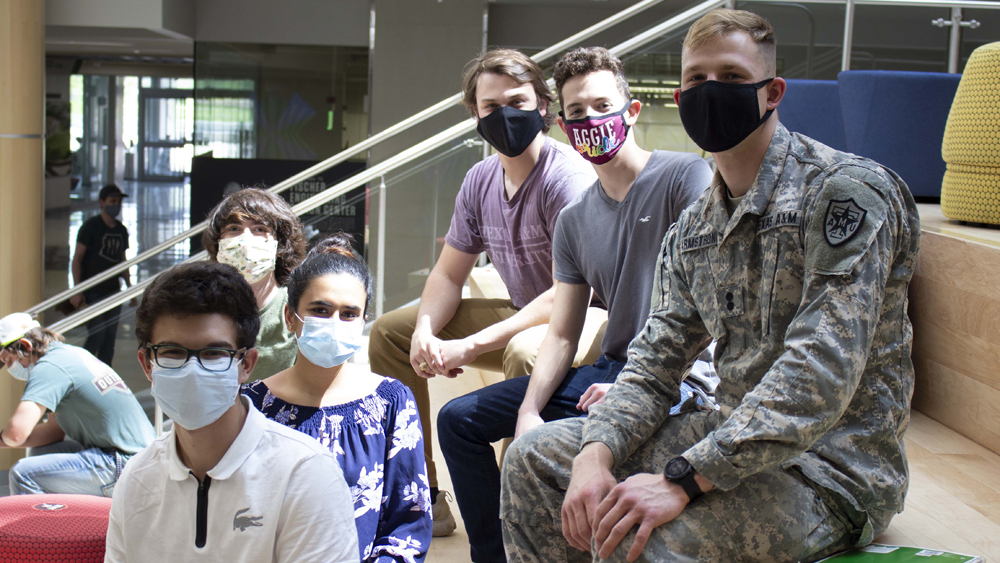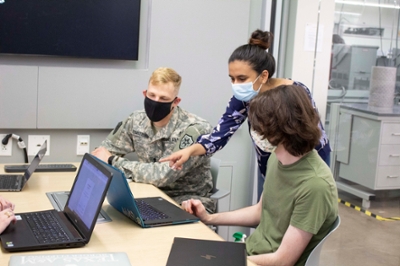
Sponsor: Texas Children’s Hospital
Intro: Cerebrospinal fluid is found within the tissue that surrounds the brain and spinal cord and works to replace fluids and maintain bodily functions. However, if this fluid begins to leak out of the spinal cavity, it can cause excess fluid to build up in the brain, creating dangerous amounts of pressure and leading to the disease hydrocephalus. While there are strategies to help clear this liquid, they’re not always effective.
That’s the challenge a group of six biomedical engineering students took on for their senior design project.
Logan Piner was excited to apply the knowledge the team had learned over the past four years to something physical.
"We’ve learned a lot about lots of different subjects as biomedical engineers, and I think that’s helped a lot in our device because we’re not making something purely mechanical or purely electrical," Piner said. "It’s got to be fit for the body, but it’s also got to run this software."
Project need: Current solutions to drain the fluid involve implanting a shunt that connects the brain to the abdomen. Due to the lower pressure in the abdomen, the fluid can passively drain from the brain. However, in some patients, including children and people who are obese, there is not enough of a pressure difference to easily let the fluid drain.
Daaniya Syeda said they’ve had a great experience working with him, especially when trying to understand what current device include. She said it’s been eye-opening seeing what all is involved in developing a medical device.
"There’s a lot of different factors such as what risk is it for the patient, biocompatibility, efficiency, usage," Syeda said. "I didn’t realize there are so many different factors, and so it’s quite difficult to find an optimum balance."

Solution: For their solution, the team is prototyping a 3D-modeled piezoelectric pump that will include a microchip with pressure and flow sensors. The sensors will allow the pump to play a more active role in controlling the movement of the liquid. It also includes Bluetooth capabilities, so it will be able to communicate and provide real-time data to patients and doctors, improving the device’s usability.
Challenges: "One challenge is just understanding what the pathology of the disease is," said team member Chris Chaftari. "It isn’t really known why people suddenly have an increase in pressure. We know that they have an excess in production of fluid and for some reason, the fluid isn’t able to drain from the head, but we really don’t know why this problem arises."
On top of the typical challenges associated with a senior capstone project, the team faced new obstacles due to the COVID-19 pandemic.
"We’re weren’t able to all meet face-to-face for a while, and that was hard in the designing part of the device," said Kevin Garcia Valdez. "It’s hard to talk to each other on how we’re going to make the device and how it’s going to look."
Broader impact for students: Along with applying their knowledge to a project, another mission of the capstone is to help students gain skills working and communicating as a group. While all of them are biomedical engineers, their backgrounds vary. Joshua Fernandez de la Vega originally came to Texas A&M to study mechanical engineering but switched to biomedical engineering after his first year.
"I don’t necessarily like sitting in a class and learning about gears for weeks on end, but being able to see an application that impacts someone has been really nice and helped me keep my focus throughout my studies," Fernandez de la Vega said.
Overall, Gordon Armstrong said having the chance to help solve a real-world problem had the greatest impact on him.
"I have been extremely fortunate to have a great team where we were all motivated to actually accomplish our project," Armstrong said. "We’ve collectively learned a lot about cerebral shunts, but most importantly, I think we’ve learned a lot about functioning as a team."